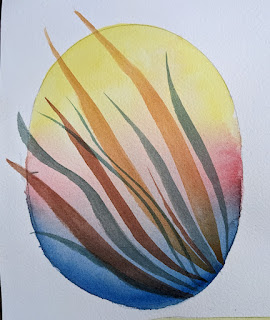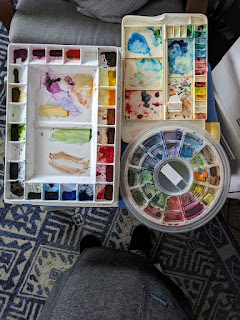Putting it all together:
Friday, January 24, 2025
Putting it all together
Monday, January 20, 2025
PEACH ROSE- CONQUERING WET IN WET
I like to watch and follow other watercolor artists as much as anyone, and I enjoy some of the challenges. I enjoy learning something new from others. But when it comes down to it, I don't want to get so sucked in that I never do anything of my own. The purpose of watching others is to bring more skills to my own work.
Therefore, I present to you my latest rose. My husband said, "Flowers, AGAIN?" Truthfully, I haven't done much in the way of flowers for some months. I enjoy the wet in wet techniques and find it rather soothing to do flower petals. And I wanted to practice the leaves.
Thursday, January 16, 2025
More about split color wheel mixing
Creating a split color wheel
Below is the first color wheel I created in Sandy Maudlin's class. It took weeks for me to complete. Since we didn't have time for that I chose a simpler color wheel. This puppy takes an entire 22 x 30 sheet of watercolor paper. Good thing I marked all my color choices with codes on the bottom left.
This lesson was all about creating colors from just 6 primaries. A "split" color wheel uses a warm and a cool of each primary. I prefer the term "leaning toward" to warm or cool. If you want very pure and clean looking secondaries (orange/green/violet) you choose primaries that "lean" toward those colors. Therefore, the "cool" yellow, which has no orange in it (like lemon) faces the "cool" blue, which leans toward green.
The warm yellow (that leans toward orange) faces the warm red (that leans toward orange). The Cool Red, such as magenta or quin rose, leans toward violet, so it faces the warm red (French ultramarine) which leans to violet.
The students downloaded this color wheel and drew it on watercolor paper. Then they combined the primaries that faced each other to make the secondary colors. My suggestion was to make the secondary color first. Example: To make a good secondary green, mix the cool yellow and the cool blue (cerulean) on the palette until you get a good green. Then add yellow to the mix to make a yellow green; then add blue to the mix until you get a bluer (more teal) green. Then move on to the other secondaries.
I would suggest labeling the colors you use so you don't get confused.
The little half circles on the outer wheel that look gray are filled with the complement (opposite) of each primary mixed with that primary to create gray or brown.
Here is a color wheel I made for myself on a larger piece of paper (11 x 14) I liked having larger spaces to color so I could see what a color looked like dark or watered down. When I was done, I went through some of my tube paints and tried to match them to where they would show up on this color wheel. It's a good way of discovering which paints you might want, which ones you don't need. The piece in the middle helps identify color schemes (triad, complementary, analogous, etc.) but there is another lesson on that on a different blog.
I was asked about my favorite colors to use. That changes from time to time, subject, and things I learned.
My Blog on split color wheel simplified
https://www.blogger.com/blog/post/edit/8812132386157895665/4240977623940030232
Split color wheel cards--If you want some homework!
https://www.blogger.com/blog/post/edit/8812132386157895665/6322867704138753851
creating a split primary wheel (16 min)
https://www.youtube.com/watch?v=8BlD6ijheyk
Thursday, January 9, 2025
Watercolor Boot Camp Week #1: Supplies, strokes
Daily I see artists struggling with concepts that I either learned or WISH I'd learned early in my watercolor journey. In this three weeks, I hope I can help artists avoid some of the pitfalls so they can progress faster.
This first week is about supplies. You honestly don't need much to begin. But your choices can greatly affect your progress.
Basically you need:
*watercolor paint, six colors
*3 watercolor brushes (about an 8 round, 3/4 " flat, and liner brush)
*100% cotton 140 lb paper
Other than that, you need a palette for your paints; some paper towels or white tissue, water, spray bottle, masking tape, something to store and protect brushes, and a willingness to experiment and make mistakes.
PAINT:
There are HUNDREDS of paint colors and brands out there. Do you choose pans or tubes? Do they have to be professional grade?
I was spoiled by having an amazing teacher when I began. She had us use the right paper and paints right from the beginning. I have my preferences, but to begin USE WHAT YOU HAVE. Professional paints have purer pigments, fewer fillers, and they perform better. Watercolor paints have several attributes that other mediums don't have, besides the "hue" or color.
TRANSPARENCY: This is probably the most important, because it is the transparency that gives watercolor it's glow and beauty. Transparency is labeled transparent/semi-transparent/opaque. It is usually not on the label, but you can get charts from manufacturers that give that information.
SEDIMENTARY: This provides texture. Some paints are not able to be ground as finely as others, which makes some particles heavy, and they granulate. Some of these are burnt sienna, French ultramarine, any of the lunar paints, etc. Professional paints will designate this on a chart.
LIGHTFAST: This means the paint will not fade over time. Some paints (Alizarin, Opera) are famous for being "FUGITIVE", which means they fade quickly. Paints will indicate by Roman numerals I, II, III, or IV, with IV being the least light fast. You want paint that is I or II.
STAINING/LIFTING: Professional paints can be staining or not, and should indicate on the label. Staining paints quickly get into the fibers of the paper, and are hard to remove or "lift." Artists take advantage of this quality in several ways. If they want to glaze other colors over another, and want the under color to not mix or lift, they will use a stainer. If you are doing flowers or a face, and you know you will be lifting high lights, you would choose LIFTING colors. Common stainers are Pthalos and Carbazole.
PIGMENT COLOR: Pro paints will provide the pigment number. This helps in comparing brands, which don't always use the same name as another brand for the same color. For example, French Ultramarine is PB (pigment blue) 29; Imperial Purple is PB 29 plus PV 19 (pigment violet). Winsor Violet is P 23, which is the same as Lucas Dioxazine or Daniel Smith Carbazole.
SERIES NO. You will see a Series No. on many paints. That doesn't indicate quality of paint. Instead, paints are priced according to what it costs to produce. Series one will be the cheapest; series 5 will be the most expensive, because they are made with the most expensive pigments.
INFLUENCE or TINTING STRENGTH: This can be important to remember when mixing colors. Yellows have very little influence, so if you want a green, you will need more yellow than blue. You would start with the yellow and add bits of blue until the hue you want is achieved.
VEHICLE or binder: Most watercolor, except for QoR, use gum Arabic as the binder, or the vehicle which the pigment is ground into. It is also the same vehicle for gouache, which is an opaque watercolor.
BRANDS:
People have their favorites, and you can mix and match them. I pretty much stick with Daniel Smith, Winsor Newton, Lucas, Holbein, M. Graham (which has honey in it), Sennelier. There are some homemade companies cropping up that also do a good job, but they can be expensive.
Student Grade: Cotman by Winsor Newton makes a pretty good student grade of paint. If that is what you have, use it, but gradually add some of the better brands to your list. Student grade will have more filler, less pigment, and miss out on some of the other qualities of watercolor paint.
TUBES OR PANS
My preference is tubes for several reasons. I always have pure paint ready if I need it.(paint in the pan, especially yellow, gets polluted by other colors). It is easier to mix a dark color, rather than struggle to reconstitute a dry paint. I can put the paint where I want it in my palette. Plus I can easily share a color with someone.
Pans are handy and usually cheaper because they have more filler. Often your set places the colors close together, and they get mixed up and need to be cleaned out constantly.
WHAT COLORS DO I NEED?
Start with a "warm" and a "cool" of every primary. In the next week we will discuss the "split primary" color wheel, which will help understand color mixing. Cool colors lean toward blue, and warm ones lean toward orange, in general. Generally speaking, you can make nearly every color with 6 primaries:
WARMS
Reds that lean toward orange (I avoid cadmiums bc they can be toxic. They do now make cad "hues")
Blues that lean toward purple -- cobalt; French Ultramarine)
Yellows that have a tint of orange
COOLS
Reds that lean toward violet (pinks; magenta, permanent rose)
Blues that lean toward green (cerulean; pthalo)
Yellows that look very pure, like lemon
You can prob get away with one yellow if it is not too light and doesn't lean to orange
I NEVER use white or black, so you don't need it.
Many colors are considered "convenience" colors, because they are mixes that are used frequently. (such as sap green). Some you get because you need something either staining or lifting. Some are heavily sedimentary, and you want that look for landscapes. Some are neutrals, such as burnt sienna. Your palette will evolve as you become more experienced and learn what subjects appeal to you.
PALETTES
Here are a few I've used over the years.
The first I'd ever painted from (outside of a plastic dish) was the one on the left. The wells are large, and it has two large mixing sections. I still use one like this at home. It allows me to have the colors I need, and to use large or small brushes. An advantage not many consider is that colors don't get mixed up, contaminated, as much as in a palette with smaller wells. Also, the lid has two additional mixing sections.
The one on the top right is a small, about 9 inch, palette. The wells are pretty small. But it does have 5 sections for mixing. I often use this to lend to students.
The bottom is a stay-wet circular one I bought because I thought it would be nice to have all my colors in the color wheel. The wells are nice size. But it has no space for mixing paint. Bummer.
I used this one for teaching and traveling for a long time. It has trays that pull out to give 3 large spaces for mixing. It cracked, and the hinge broke, which is a weakness with palettes by Mijello. After that I bought the larger one, above, and was disappointed. So, for traveling and teaching I am going back to this one.


















